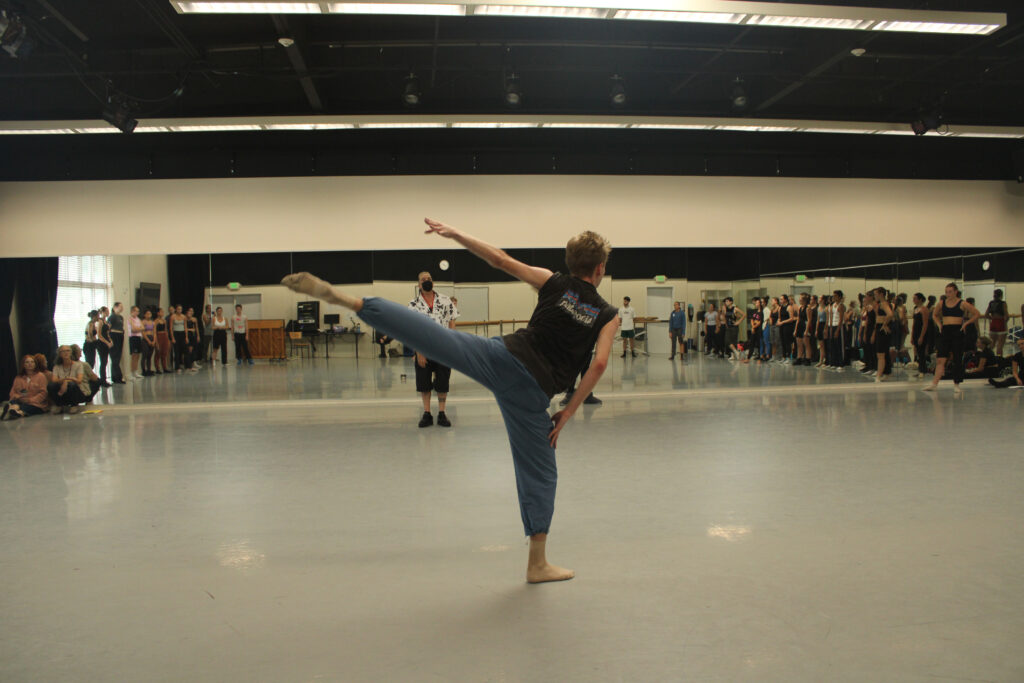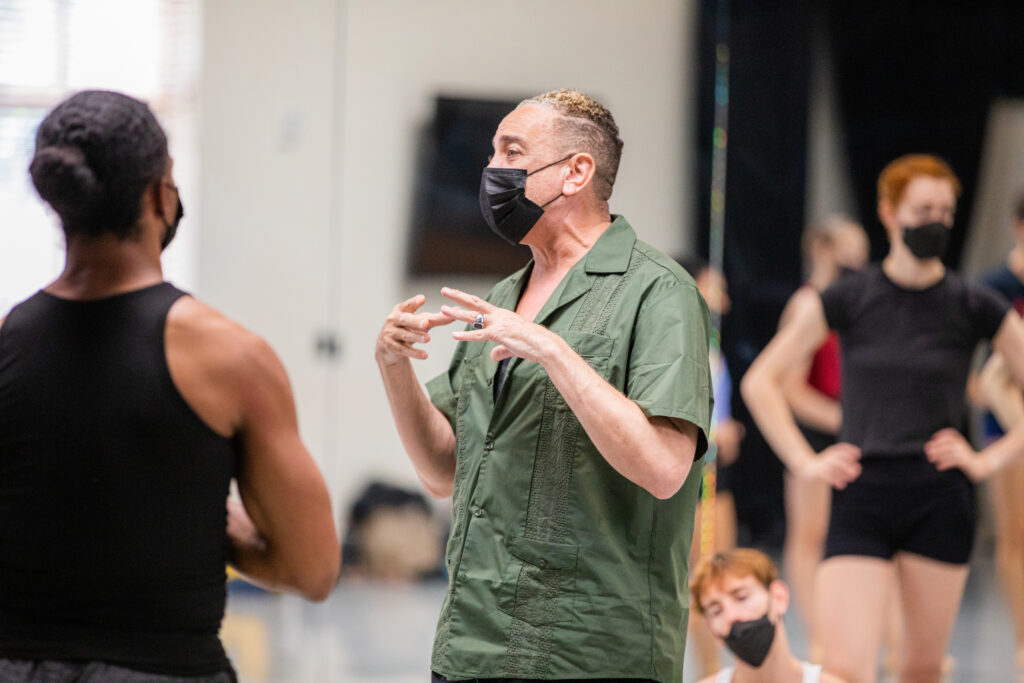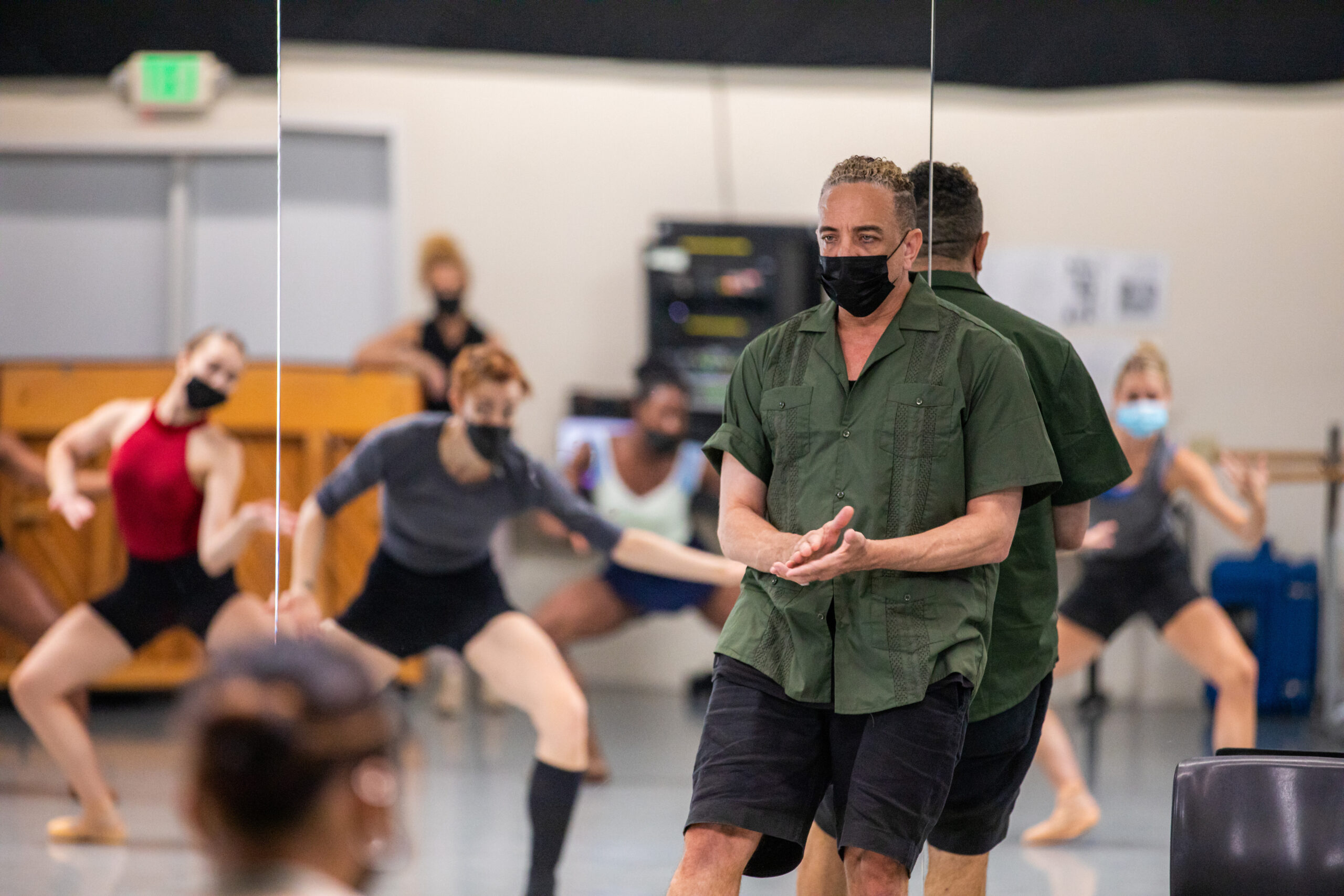Dwight Rhoden Brings Contemporary Ballet and Professional Connections to Chapman University
It isn’t easy to hide Dwight Rhoden. Not just because he’s a tall man with a captivating presence and distinctive goatee. He’s also a big name with a storied career who turns heads in a room full of dancers. Which made the surprise announcement following Chapman University’s fall dance concert in December 2021—that Rhoden would be joining the dance department as a full-time faculty member in the fall of 2022—feel like a clandestine mission.
“It was a stealth operation that barely worked,” says professor and dance department chair Julianne O’Brien. They had to sneak Rhoden into the balcony to watch the performance and then dodge stragglers en route to the stage where they’d told the students to gather afterward. But it was worth it. “People were shocked,” O’Brien says. “There’s this great picture of all the students’ mouths, like—”she says, demonstrating the unchoreographed moment of jaws dropping in tandem.
“It was a wonderful way to be welcomed in,” says Rhoden, founding artistic director and resident choreographer of Complexions Contemporary Ballet. The choreographer’s first visit to the school in Orange, California, as part of a Dance Masters at Chapman concert and intensive in 2018, was so successful he came back with his company the next year in a pair of pre-pandemic prologues that set the stage for something more permanent. Rhoden and O’Brien—who met through their colleague Ido Tadmor—felt it couldn’t be a better fit for both sides.
“I just kind of fell in love with the program,” says Rhoden, who has a long history teaching and choreographing in higher ed settings, including at New York University, The Juilliard School, University of California Irvine, Skidmore College, and the University of Mississippi. At Chapman, he says, there was “a great vibe in the studio and in the program and the people.” He was inspired by the faculty’s openness and commitment to the progress of their charges, and eager to help support, mentor, and shape the next generation of dancers he’d so enjoyed working with.

The stars aligned at a time when Rhoden was looking for a new challenge and Chapman’s dance department was seeing a swell of interest and investment—including the new Sandi Simon Center for Dance, a large, light-filled building with spacious studios that opened in 2023. “I felt like I could make a difference there,” he says. “That there was something that I could offer the program that they did not have.”
What he could offer, for one, was contemporary ballet. Chapman hadn’t been providing the kind of variety in ballet that O’Brien was proud to have in modern and jazz. “In terms of pedagogy, he filled a gap that we’ve been needing for years,” she says. “It’s been wonderful for our students—the shifts of weight, the musicality, the coordination—not just for their bodies but for their brains.”
Anyone who’s ever seen Rhoden’s choreography would understand why O’Brien considers him a great example of what she calls the “and” approach Chapman believes in: You don’t pick one genre or another and train in isolation. Not only does Rhoden want to “disarm any kind of uncomfortability with classical technique,” but he also wants to equip students to work at the intersections. “Look at the world,” Rhoden says. “They’re going to be more prepared because we are not moving only in pure forms. Most people are making works that are fusion.”
When he first arrived, he sensed some nerves, unease, and even fear. “The first semester was a little challenging. I mean, we found our way for sure, but I had to get to know them,” Rhoden says. “I love young people and I love to see them understand or even help them through a hard moment, like where they don’t think they can do it,” he says. It’s a nurturing environment, and “you have to do it with love, but you really do sometimes have to push them.”
In addition to contemporary ballet classes in his first year on campus, Rhoden co-taught a pedagogy course with O’Brien and Wilson Mendieta, choreographed a new work on students, and led repertory classes—where he set phrases of material and coached students to find their unique voices. That’s one of his favorite things, he says, “taking the movement and helping the artists make it speak.”
Students and faculty feel the impact. “I can see a change in the students’ bodies and how they approach movement. It’s quite beautiful,” Mendieta says. Ande Godwin, a junior BFA dance major, says that “working with Dwight has been an eye-opening experience to the capabilities of the human body.” He also helped her find her voice. “He is teaching our generation to feel and be heard through dance. He cares about what we have to say as a dancer, which is what makes him so loved.”

As a current artistic leader of a well-known company, Rhoden is also giving the students a view into the professional dance world. Last February, those college and company spheres collided when Complexions came back to campus for a weeklong residency. The immersion gave both sides perspective, Rhoden says. For the students, it “really delivered a message that the work is never done—and I think that’s positive. I mean, the day I retired or left the stage, I was still working on something,” he says. “And for the professionals, I think they look back and see: ‘Wow, I’ve come a long way. I remember being not sure or having more missing pieces.’ ”
Balancing his many obligations between Chapman on one coast and Complexions on the other hasn’t always been easy. But the university has been flexible to accommodate occasional mid-semester travel. When he returned from one such trip last spring, Rhoden was astonished to see how much his repertory students had absorbed and grown. “They had stepped into the movement, fully put it on, and it was theirs,” he says. “They were killing it. I mean, we were dancing to everything from Kendrick Lamar and Lil Wayne to Bach and Chopin,” he added. And “they were achieving it. So much talent in that class. I want them all back again.”
But he also wants to keep getting to know every student in the program and to help the school continue diversifying its dance cohorts, from artistic and demographic perspectives. This year, he’s teaching ballet, contemporary pointe, and repertory classes and choreographing new works. He was already part of a retreat last spring where faculty discussed the curriculum, and O’Brien is looking forward to his continued involvement in the conversations that are shaping the future of the department.
“He brings so much to the table,” O’Brien says. And he’s only just getting started.




